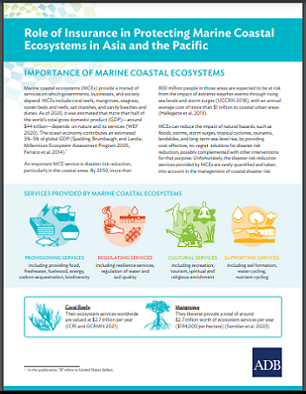
Marine coastal ecosystems (MCEs) provide a myriad of services on which governments, businesses, and society depend. MCEs include coral reefs, mangroves, seagrass, oyster beds and reefs, salt marshes, and sandy beaches and dunes. As of 2020, it was estimated that more than half of the world’s total gross domestic product (GDP)—around $44 trillion—depends on nature and its services (WEF 2020). The ocean economy contributes an estimated 3%–5% of global GDP (Spalding, Brumbaugh, and Landis; Millennium Ecosystem Assessment Program 2005; Ferrario et al. 2014). An important MCE service is disaster risk reduction, particularly in the coastal areas. By 2050, more than 800 million people in those areas are expected to be at risk from the impact of extreme weather events through rising sea levels and storm surges (UCCRN 2018), with an annual average cost of more than $1 trillion to coastal urban areas (Hallegatte et al. 2013). MCEs can reduce the impact of natural hazards, such as floods, storms, storm surges, tropical cyclones, tsunamis, landslides, and long-term sea-level rise, by providing cost-effective, no-regret solutions for disaster risk reduction, possibly complemented with other interventions for that purpose. Unfortunately, the disaster risk reduction services provided by MCEs are rarely quantified and taken into account in the management of coastal disaster risk.














